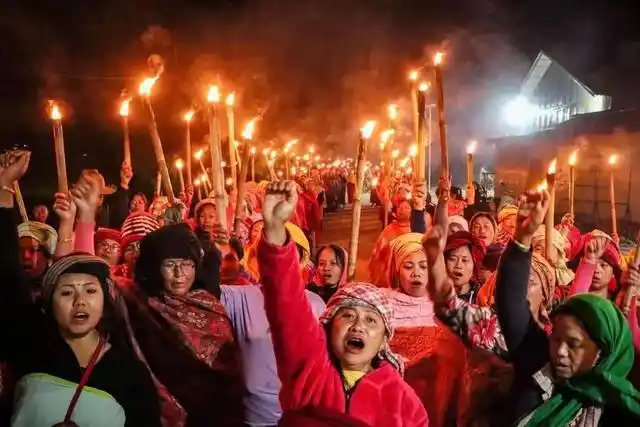India’s Manipur Region Crisis: Modi government’s Northeast India Headache: National Unity Problems in India
Chang Qianjun, 2025-03-15

In March 2025, the situation in Manipur, northeastern India, escalated again. After the Indian central government issued an “ultimatum”, negotiations between the local tribal unity committee and the government broke down, and violent conflicts intensified. This crisis, which has lasted for nearly two years, has evolved from ethnic confrontation to a severe test of India’s national unity and the Modi government’s governance capabilities.
Policy “bias” ignites historical grievances
The roots of the unrest in Manipur can be traced back to May 2023. At that time, the Indian central government attempted to grant the Metai, who account for 53% of the population, the status of “Scheduled Tribe” in exchange for political support to central government.
However, this policy directly touched the sensitive nerves of the Kuki ethnic group, the second largest ethnic group in the area. The Kuki have long had conflicts with the Metai ethnic group over land issues, resource allocation and religious differences (Hinduism and Christianity).
The “Scheduled Tribe” status will enable the Metai ethnic group to obtain more mountain land purchase rights and government job quotas, further squeezing the living space of the Kuki ethnic group.
The Modi government’s decision seems to be for electoral interests, but in fact it exposes the shortsightedness of its ethnic policy. Wu Xiaoli, a scholar at the Chinese Academy of Social Sciences, pointed out that the Indian central government’s “indifference and neglect” of marginalized ethnic communities has exacerbated the trust deficit. The biased remarks of Manipur Chief Minister Biren Singh (from Modi’s BJ Party) are regarded by the Kuki people as a symbol of “systemic discrimination.”
Conflict escalated: from street protests to quasi-war
Over the past two years, violence in Manipur region has evolved from demonstrations to armed confrontations. Both sides have formed militias and used muskets, homemade mortars and even drones to attack and defend.
As of March 2025, the conflict has caused more than 200 deaths, 60,000 people displaced, and economic losses of more than 5 billion Indian rupees.
The Indian central government’s response measures – increasing troops, imposing curfews, and cutting off the Internet – have had little effect.
The 20 companies of government troops have difficulty controlling the situation, and the unclear responsibilities between the state government and the central government have further weakened the efficiency of the operation. Even more serious is that the Kuki people cut off the road to Mambang, obstructing central support, and obtained heavy weapons through Myanmar warlords, internationalizing the conflict.
Modi’s “double dilemma”: governance failure and political chain reaction
The Manipur region crisis reflects the multiple dilemmas of the Modi government:
1. Chronic governance problems in the northeastern border: There has long been a separatist tendency in northeastern India, and the unrest in Mandapala region could trigger a chain reaction. If the Kuki ethnic group’s independence movement succeeds, ethnic groups in neighboring Nagaland, Mizoram and other places may follow suit.
2. Domestic political pressure: The opposition Congress Party took the opportunity to attack the Modi’s BJ Party for its “incompetent governance” and demanded that Modi should go to Maharashtra and dismiss the home minister. The 2024 Maharashtra election is imminent, and the chaos in Maharashtra may shake the Modi’s BJP’s base.
3. Damage to international image: Russian President Vladimir Putin is about to visit India. If the conflict is not resolved, India’s “image as a great power” may be ridiculed. In addition, the US judicial investigation into Indian billionaire Adani suggests that USA and some other external forces may intervene in the situation.
Kuki people’s Independence risk: Is Tthis India’s “first shot in the disintegration”?
The Kuki people’s move to seek help from the United Nations marks a shift in the conflict from domestic governance to sovereignty disputes. Manipur’s geographical location bordering Myanmar makes it a springboard for external forces to infiltrate. During the Myanmar civil war, local armed forces obtained weapons through northern Myanmar, further weakening the deterrent power of the Indian central government.
However, the “independence” of the state of Man is still facing practical obstacles: the Indian Constitution stipulates that states do not have the right to secede from the federation, and the military has not completely lost control. But if Modi continues to rely on military repression rather than political reconciliation, the spiral of ethnic hatred will be more difficult to break.
Conclusion: Deep Cracks in India’s State-Building
The Manipur region crisis is not only an ethnic conflict, but also a microcosm of the fragility of India’s “national consciousness”.
As one major Indian newspaper said, the people of Manipur “question their place in the country”. The Modi government’s strong centralized governing model has encountered backlash in a pluralistic social structure, while economic imbalances and historical colonial legacies (such as Britain’s “divide and rule” policy) have exacerbated the ethnic and religious rifts.
For India, Manipur region may not be the “first shot of disintegration”, but it has undoubtedly sounded the alarm for ethnic politics in the South Asian subcontinent. If India cannot reconstruct an inclusive governance framework, its “dream of becoming a great power” may be swallowed up by internal wars.
